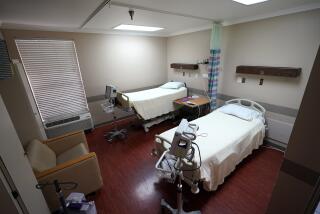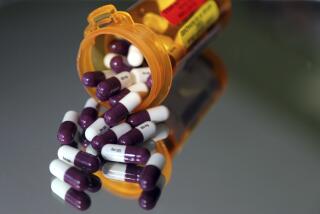U.S. healthcare tab to keep rising, led by higher costs for drugs and services, government report says
- Share via
Reporting from Washington — Driven by rising prices for drugs and medical services, the nation’s healthcare tab will continue to outpace economic growth over the next decade, according to a new government report.
And by 2026, healthcare spending will account for almost one-fifth of the U.S. economy, an all-time record.
The new report, which was prepared by independent economists at the U.S. Department of Health and Human Services and is widely regarded as an important measure of the nation’s healthcare system, echoes many recent warnings about rising costs.
At the same time, the report underscores the increasing urgency of confronting the ever-growing burden that healthcare imposes on family checkbooks and government spending.
“High and rising costs expose two often overlooked problems,” Harvard economist David Cutler noted in an article accompanying the new spending projections, published in the journal Health Affairs.
“First, spending is too high because many dollars are wasted. … Second, high medical costs combined with stagnant incomes for a large share of the population and the inability of governments at all levels to raise tax dollars leads to increased health and economic disparities,” Cutler wrote.
The report indicates that the rate of rising costs has moderated somewhat compared to the years before the 2008 Great Recession.
From 1990 to 2007, healthcare spending increased 7.3% a year on average, far outpacing economic growth.
By contrast, annual spending is projected to increase 5.5% on average between 2017 and 2026, the report’s authors conclude.
But the future spending growth is considerably faster than in the decade following the recession, when costs increased 4.2% annually on average.
More worrisome, the annual growth rate over the next decade is expected to average one percentage point more than overall economic growth.
That means that healthcare will expand from about 17.9% of the economy in 2016 to 19.7% of the economy in 2026.
Some of the increase reflects the fact that the U.S. population is aging and will therefore require more medical care, the authors note.
Steady economic growth over the next decade will probably drive some increase in health spending, as has happened in previous economic expansions.
But the report concludes that the biggest drivers of rising spending are likely to be higher costs for care and, particularly, for prescription drugs. Spending on retail drugs is projected to increase 6.3% a year on average over the next decade.
The U.S. already has the highest medical prices in the world, research indicates.
And as public outrage over the price of prescription drugs and many medical services increases, there are growing calls by Democrats for more government regulation of prices, a practice common in other industrialized countries.
But Republicans oppose such efforts, instead backing plans to cut government healthcare assistance, which could restrain spending by making it more difficult for many patients to pay for medical care.
ALSO
More to Read
Get the L.A. Times Politics newsletter
Deeply reported insights into legislation, politics and policy from Sacramento, Washington and beyond. In your inbox three times per week.
You may occasionally receive promotional content from the Los Angeles Times.











